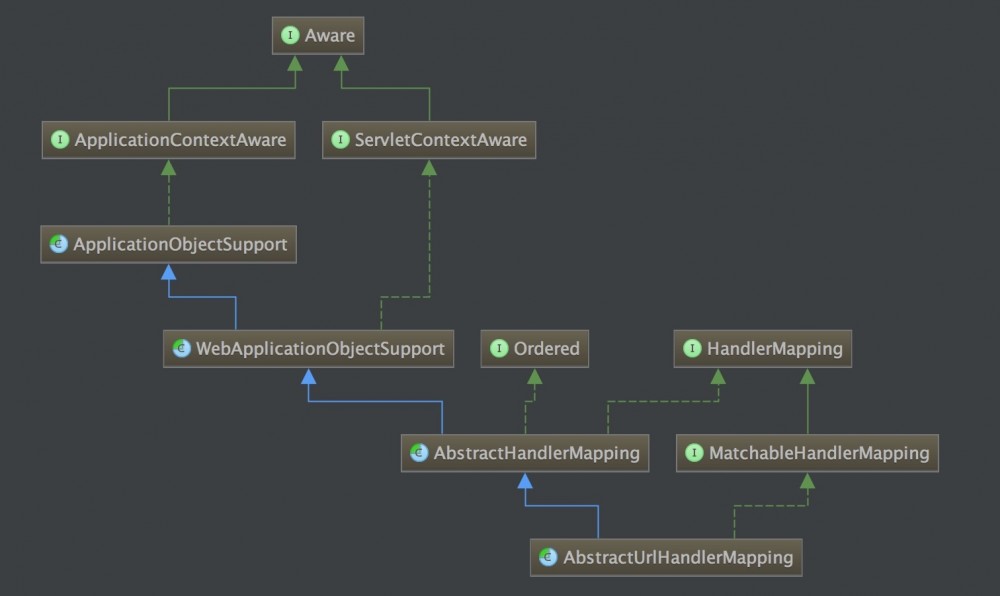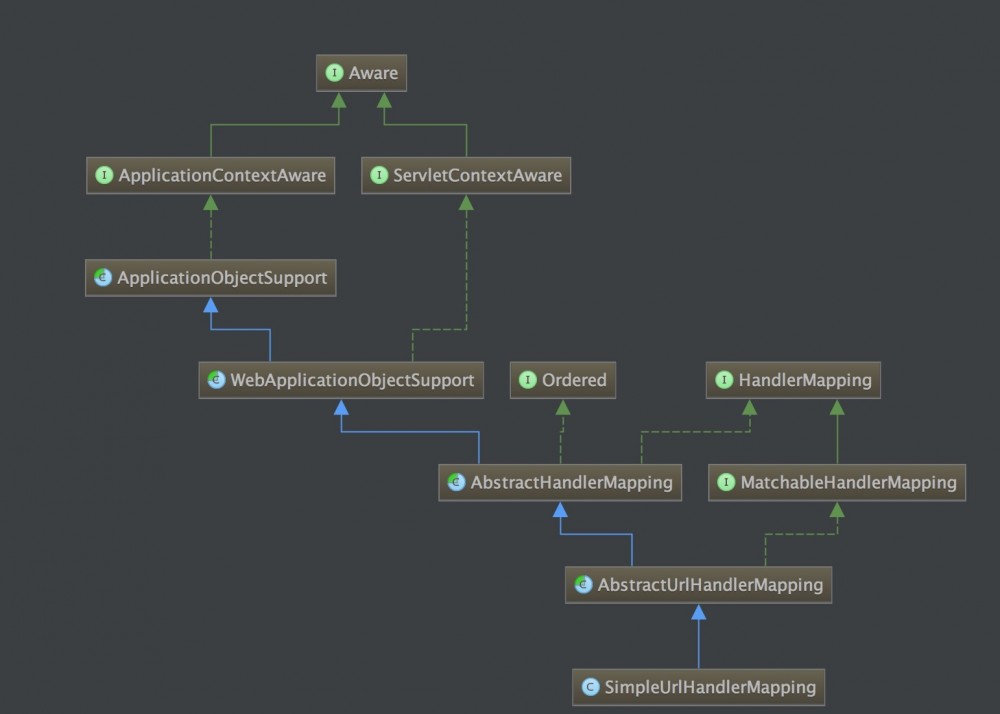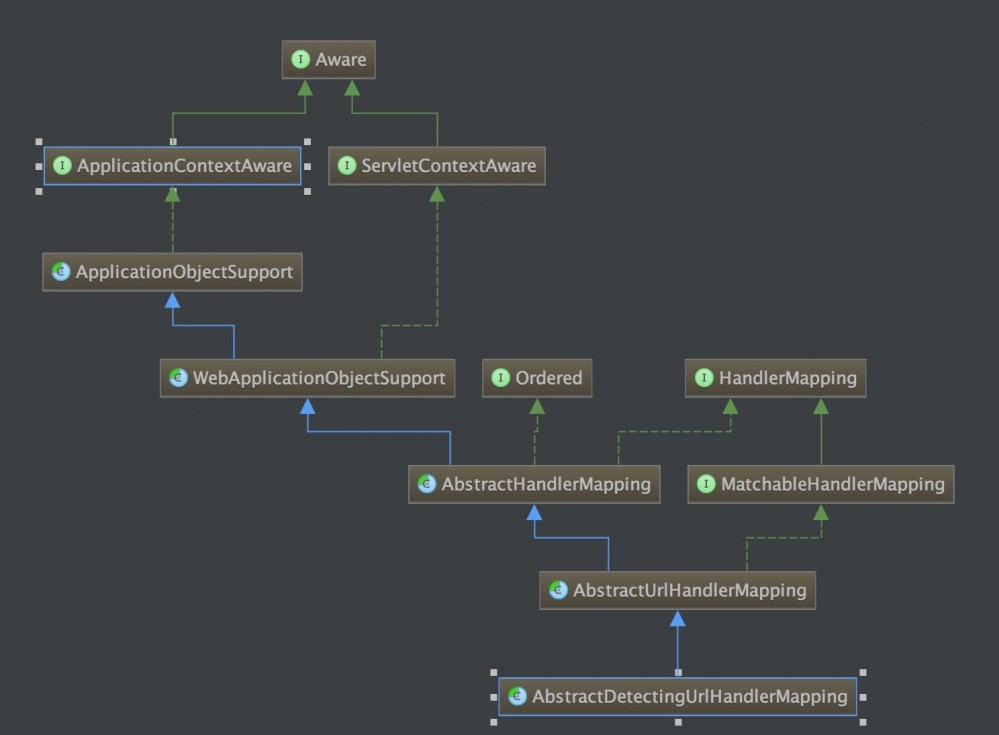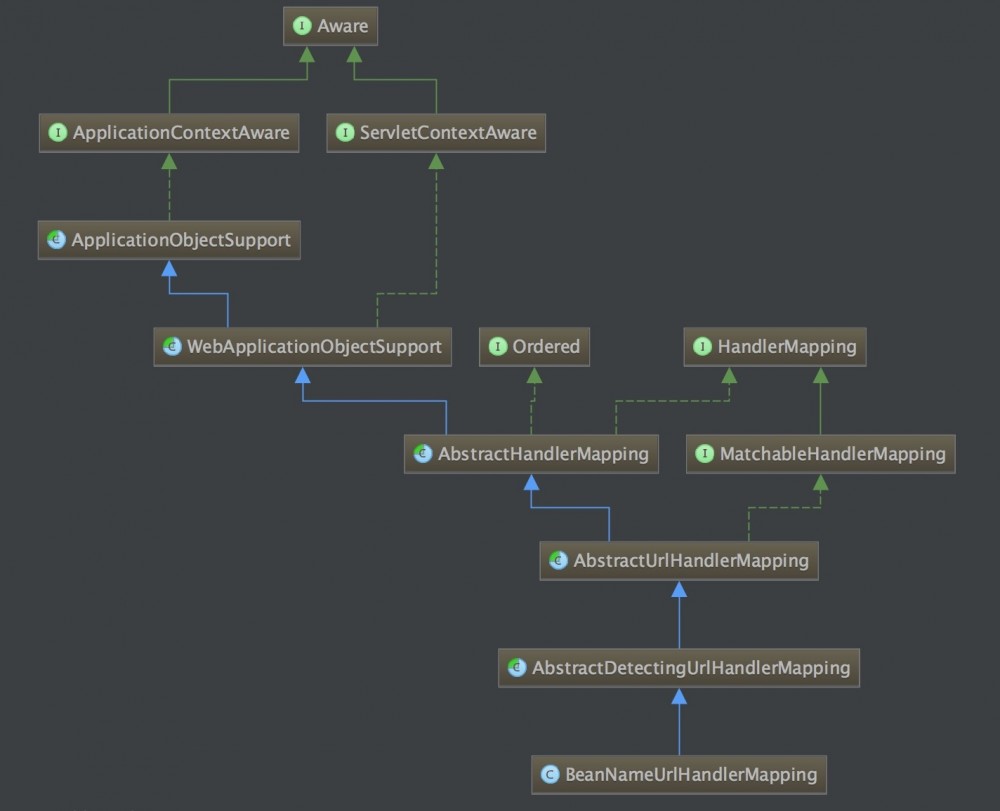SpringMVC源码分析--HandlerMappings
之前分析过 SpringMVC 中的 DispatcherServlet ,分析了 SpringMVC 处理请求的过程。但忽略了一些 DispatcherServlet 协助请求处理的组件,例如 SpringMVC 中的 HandlerMapping 、 HandlerAdapter 、 ViewResolvers 等等。
HandlerMappings
HandlerMappings 在 DispathServlet 中主要作用是为请求的 urlpath 匹配对应的 Controller ,建立一个映射关系,根据请求查找 Handler 、 Interceptor 。 HandlerMappings 将请求传递到 HandlerExecutionChain 上, HandlerExecutionChain 包含了一个能够处理该请求的处理器,还可以包含拦截改请求的拦截器。
在没有处理器映射相关配置情况下, DispatcherServlet 会为你创建一个 BeanNameUrlHandlerMapping 作为默认映射的配置。在 DispatchServlet.properties 文件中对于 HandlerMapping 的默认配置是:
org.springframework.web.servlet.HandlerMapping=org.springframework.web.servlet.handler.BeanNameUrlHandlerMapping,/ org.springframework.web.servlet.mvc.annotation.DefaultAnnotationHandlerMapping
HandlerMapping 的配置策略一般分为配置式 BeanNameUrlHandlerMapping 和注解式 DefaultAnnotationHandlerMapping 。不过 DefaultAnnotationHandlerMapping 已经被放弃了,取代它的是 RequestMappingHandlerMapping ,不知道为啥 SpringMVC 这个默认配置尚未做修改。
AbstractHandlerMapping

AbstractHandlerMapping 是 HandlerMapping 的抽象实现,是所有 HandlerMapping 实现类的父类。
AbstractHandlerMapping 的作用是是为了初始化 Interceptors 。 AbstractHandlerMapping 重写了 WebApplicationObjectSupport 的 initApplicationContext 方法。
protected void initApplicationContext()throwsBeansException{
extendInterceptors(this.interceptors);
detectMappedInterceptors(this.adaptedInterceptors);
initInterceptors();
}
-
extendInterceptors方法,Springmvc并没有做出具体实现,这里留下一个拓展,子类可以重写这个模板方法,为子类添加或者修改Interceptors。 -
detectMappedInterceptors方法将SpringMVC容器中所有MappedInterceptor类的bean添加到adaptedInterceptors中。 - 最后调用
initInterceptors初始化拦截器。遍历interceptors将WebRequestInterceptor和HandlerInterceptor类型的拦截器添加到adaptedInterceptors中。
HandlerMapping 通过 getHandler 方法来获取请求的处理器 Handler 和拦截器 Interceptor 。在 getHandlerExecutionChain 方法中将遍历之前初始化的 adaptedInterceptors ,为当前的请求选择对应的 MappedInterceptors 和 adaptedInterceptors 。
AbstractUrlHandlerMapping
AbstractUrlHandlerMapping

AbstractUrlHandlerMapping 继承于 AbstractHandlerMapping ,它是通过 URL 来匹配具体的 Handler 。 AbstractUrlHandlerMapping 维护一个 handlerMap 来存储 Url 和 Handler 的映射关系。
AbstractUrlHandlerMapping 重写了 AbstractHandlerMapping 类中的 getHandlerInternal 方法。 HandlerMapping 通过 getHandler 方法,就会调用这里的 getHandlerInternal 方法来获取 Handler 。 getHandlerInternal 方法中关键调用 lookupHandler 方法去获取 handler 。
protectedObjectlookupHandler(String urlPath, HttpServletRequest request)throwsException{
// Direct match?
Object handler = this.handlerMap.get(urlPath);
if (handler != null) {
// Bean name or resolved handler?
if (handler instanceof String) {
String handlerName = (String) handler;
handler = getApplicationContext().getBean(handlerName);
}
validateHandler(handler, request);
return buildPathExposingHandler(handler, urlPath, urlPath, null);
}
// Pattern match?
List<String> matchingPatterns = new ArrayList<String>();
for (String registeredPattern : this.handlerMap.keySet()) {
if (getPathMatcher().match(registeredPattern, urlPath)) {
matchingPatterns.add(registeredPattern);
}
else if (useTrailingSlashMatch()) {
if (!registeredPattern.endsWith("/") && getPathMatcher().match(registeredPattern + "/", urlPath)) {
matchingPatterns.add(registeredPattern +"/");
}
}
}
String bestMatch = null;
Comparator<String> patternComparator = getPathMatcher().getPatternComparator(urlPath);
if (!matchingPatterns.isEmpty()) {
Collections.sort(matchingPatterns, patternComparator);
if (logger.isDebugEnabled()) {
logger.debug("Matching patterns for request [" + urlPath + "] are " + matchingPatterns);
}
bestMatch = matchingPatterns.get(0);
}
if (bestMatch != null) {
handler = this.handlerMap.get(bestMatch);
if (handler == null) {
if (bestMatch.endsWith("/")) {
handler = this.handlerMap.get(bestMatch.substring(0, bestMatch.length() - 1));
}
if (handler == null) {
throw new IllegalStateException(
"Could not find handler for best pattern match [" + bestMatch + "]");
}
}
// Bean name or resolved handler?
if (handler instanceof String) {
String handlerName = (String) handler;
handler = getApplicationContext().getBean(handlerName);
}
validateHandler(handler, request);
String pathWithinMapping = getPathMatcher().extractPathWithinPattern(bestMatch, urlPath);
// There might be multiple 'best patterns', let's make sure we have the correct URI template variables
// for all of them
Map<String, String> uriTemplateVariables = new LinkedHashMap<String, String>();
for (String matchingPattern : matchingPatterns) {
if (patternComparator.compare(bestMatch, matchingPattern) == 0) {
Map<String, String> vars = getPathMatcher().extractUriTemplateVariables(matchingPattern, urlPath);
Map<String, String> decodedVars = getUrlPathHelper().decodePathVariables(request, vars);
uriTemplateVariables.putAll(decodedVars);
}
}
if (logger.isDebugEnabled()) {
logger.debug("URI Template variables for request [" + urlPath + "] are " + uriTemplateVariables);
}
return buildPathExposingHandler(handler, bestMatch, pathWithinMapping, uriTemplateVariables);
}
// No handler found...
return null;
}
- 首先调用
lookupHandler方法来获取handler。在lookupHandler方法中,先通过URL在handlerMap查找是否有合适的handler。 - 如果没有获取到
handler,遍历handlerMap利用正则匹配的方法,找到符合要求的handlers(有可能是多个)。 - 正则匹配是采用
Ant风格,将会通过排序筛选出一个匹配程度最高的Handler。 - 最后调用
buildPathExposingHandler方法构建一个handler,添加PathExposingHandlerInterceptor和UriTemplateVariablesHandlerInterceptor两个拦截器并返回。
上面介绍获取 handler 的过程中,会先从 handlerMap 查找。下面看一下 handlerMap 是如何初始化的。 AbstractUrlHandlerMapping 是通过 registerHandler 初始化 handlerMap 的。 AbstractUrlHandlerMapping 共有两个 registerHandler 方法。分别是注册多个 url 到一个 handler 和注册一个 url 到一个 handler 。首先判断 handlerMap 是否有此 handler 。如果存在的话,判断是否一致,不一致则抛出异常,如果不存在的话,如果 url 是 / 、 /* ,则,返回 root handler 、 default handler ,如果不是将添加到 handlerMap 中。
SimpleUrlHandlerMapping

SimpleUrlHandlerMapping 继承于 AbstractUrlHandlerMapping 。 SimpleUrlHandlerMapping 重写了父类 AbstractHandlerMapping 中的初始化方法 initApplicationContext 。在 initApplicationContext 方法中调用 registerHandlers 方法。
protected void registerHandlers(Map<String, Object> urlMap)throwsBeansException{
if (urlMap.isEmpty()) {
logger.warn("Neither 'urlMap' nor 'mappings' set on SimpleUrlHandlerMapping");
}
else {
for (Map.Entry<String, Object> entry : urlMap.entrySet()) {
String url = entry.getKey();
Object handler = entry.getValue();
// Prepend with slash if not already present.
if (!url.startsWith("/")) {
url = "/" + url;
}
// Remove whitespace from handler bean name.
if (handler instanceof String) {
handler = ((String) handler).trim();
}
registerHandler(url, handler);
}
}
}
判断是 url 是否以 / 开头,如果不是,默认补齐 / ,确保所有的url都是以 / 开头,然后依次调用父类的 registerHandler 方法注册到 AbstractUrlHandlerMapping 中的 handlerMap 。
在使用 SimpleUrlHandlerMapping 时,需要在注册的时候配置其 urlmap 否则会抛异常。
AbstractDetectingUrlHandlerMapping

AbstractDetectingUrlHandlerMapping 类继承于 AbstractUrlHandlerMapping 类,重写了 initApplicationContext 方法,在 initApplicationContext 方法中调用了 detectHandlers 方法。
protected void detectHandlers()throwsBeansException{
if (logger.isDebugEnabled()) {
logger.debug("Looking for URL mappings in application context: " + getApplicationContext());
}
String[] beanNames = (this.detectHandlersInAncestorContexts ?
BeanFactoryUtils.beanNamesForTypeIncludingAncestors(getApplicationContext(), Object.class) :
getApplicationContext().getBeanNamesForType(Object.class));
// Take any bean name that we can determine URLs for.
for (String beanName : beanNames) {
String[] urls = determineUrlsForHandler(beanName);
if (!ObjectUtils.isEmpty(urls)) {
// URL paths found: Let's consider it a handler.
registerHandler(urls, beanName);
}
else {
if (logger.isDebugEnabled()) {
logger.debug("Rejected bean name '" + beanName + "': no URL paths identified");
}
}
}
}
获取所有容器的 beanNames ,遍历所有的 beanName ,调用 determineUrlsForHandler 方法解析 url ,这里的 determineUrlsForHandler 也是运用了模板方法设计模式,具体的实现在其子类中,如果解析到子类,将注册到父类的 handlerMap 中。
BeanNameUrlHandlerMapping
BeanNameUrlHandlerMapping 类的类图大致如下:

BeanNameUrlHandlerMapping 类继承于 AbstractDetectingUrlHandlerMapping 类。重写了父类中的 determineUrlsForHandler 方法。
protected String[] determineUrlsForHandler(String beanName) {
List<String> urls = new ArrayList<String>();
if (beanName.startsWith("/")) {
urls.add(beanName);
}
String[] aliases = getApplicationContext().getAliases(beanName);
for (String alias : aliases) {
if (alias.startsWith("/")) {
urls.add(alias);
}
}
return StringUtils.toStringArray(urls);
}
其通过 beanName 解析 Url 规则也很简单,判断 beanName 是否以 / 开头。
BeanNameUrlHandlerMapping 是 SpringMVC 的默认映射配置。
AbstractHandlerMethodMapping
通常我们也习惯于用 @Controller 、 @Re questMapping 来定义 Handler , AbstractHandlerMethodMapping 可以将 method 作为 Handler 来使用。
AbstractHandlerMethodMapping 实现了 InitializingBean 接口,实现了 afterPropertiesSet 方法。当容器启动的时候会调用 initHandlerMethods 注册委托 handler 中的方法。
public void afterPropertiesSet(){
initHandlerMethods();
}
protected void initHandlerMethods(){
if (logger.isDebugEnabled()) {
logger.debug("Looking for request mappings in application context: " + getApplicationContext());
}
String[] beanNames = (this.detectHandlerMethodsInAncestorContexts ?
BeanFactoryUtils.beanNamesForTypeIncludingAncestors(getApplicationContext(), Object.class) :
getApplicationContext().getBeanNamesForType(Object.class));
for (String beanName : beanNames) {
if (!beanName.startsWith(SCOPED_TARGET_NAME_PREFIX)) {
Class<?> beanType = null;
try {
beanType = getApplicationContext().getType(beanName);
}
catch (Throwable ex) {
// An unresolvable bean type, probably from a lazy bean - let's ignore it.
if (logger.isDebugEnabled()) {
logger.debug("Could not resolve target class for bean with name '" + beanName + "'", ex);
}
}
if (beanType != null && isHandler(beanType)) {
detectHandlerMethods(beanName);
}
}
}
handlerMethodsInitialized(getHandlerMethods());
}
在 initHandlerMethods 方法中,做了以下工作:
- 首先通过
BeanFactoryUtils扫描应用上下文,获取所有的bean。 - 遍历所有的
beanName,调用isHandler方法判断是目标bean是否包含@Controller或@RequestMapping注解。 - 对于带有
@Controller或@RequestMapping注解的类,调用detectHandlerMethods委托处理,获取所有的method,并调用registerHandlerMethod注册所有的方法。
在 detectHandlerMethods 方法负责将 Handler 保存到 Map 中。
protected void detectHandlerMethods(finalObject handler){
// 获取handler的类型
Class<?> handlerType = (handler instanceof String ?
getApplicationContext().getType((String) handler) : handler.getClass());
final Class<?> userType = ClassUtils.getUserClass(handlerType);
Map<Method, T> methods = MethodIntrospector.selectMethods(userType,
new MethodIntrospector.MetadataLookup<T>() {
@Override
publicTinspect(Method method){
try {
return getMappingForMethod(method, userType);
}
catch (Throwable ex) {
throw new IllegalStateException("Invalid mapping on handler class [" +
userType.getName() + "]: " + method, ex);
}
}
});
if (logger.isDebugEnabled()) {
logger.debug(methods.size() + " request handler methods found on " + userType + ": " + methods);
}
for (Map.Entry<Method, T> entry : methods.entrySet()) {
Method invocableMethod = AopUtils.selectInvocableMethod(entry.getKey(), userType);
T mapping = entry.getValue();
registerHandlerMethod(handler, invocableMethod, mapping);
}
}
selectMethods 方法中重写了 MetadataLookup 中的 inspect 方法, inspect 方法中调用了子类 RequestMappingHandlerMapping 实现了 getMappingForMethod 模板方法,用于构建 RequestMappingInfo 。
public static <T> Map<Method, T>selectMethods(Class<?> targetType,finalMetadataLookup<T> metadataLookup){
final Map<Method, T> methodMap = new LinkedHashMap<Method, T>();
Set<Class<?>> handlerTypes = new LinkedHashSet<Class<?>>();
Class<?> specificHandlerType = null;
if (!Proxy.isProxyClass(targetType)) {
handlerTypes.add(targetType);
specificHandlerType = targetType;
}
handlerTypes.addAll(Arrays.asList(targetType.getInterfaces()));
for (Class<?> currentHandlerType : handlerTypes) {
final Class<?> targetClass = (specificHandlerType != null ? specificHandlerType : currentHandlerType);
ReflectionUtils.doWithMethods(currentHandlerType, new ReflectionUtils.MethodCallback() {
@Override
public void doWith(Method method){
Method specificMethod = ClassUtils.getMostSpecificMethod(method, targetClass);
T result = metadataLookup.inspect(specificMethod);
if (result != null) {
Method bridgedMethod = BridgeMethodResolver.findBridgedMethod(specificMethod);
if (bridgedMethod == specificMethod || metadataLookup.inspect(bridgedMethod) == null) {
methodMap.put(specificMethod, result);
}
}
}
}, ReflectionUtils.USER_DECLARED_METHODS);
}
return methodMap;
}
在 selectMethods 通过反射获取所有的方法,重写了 doWith 方法,将 handler 中的 method 和请求对应的 RequestMappingInfo 保存到 methodMap 中。
最终 detectHandlerMethods 将遍历这个 methodMap ,调用 registerHandlerMethod 注册 HandlerMethod 到 MappingRegistry 。
在 AbstractHandlerMethodMapping 类中,有个内部类 MappingRegistry ,用来存储 mapping 和 handler methods 注册关系,并提供了并发访问方法。
AbstractHandlerMethodMapping 通过 getHandlerInternal 来为一个请求选择对应的 handler 。
protectedHandlerMethodgetHandlerInternal(HttpServletRequest request)throwsException{
// 根据request获取对应的urlpath
String lookupPath = getUrlPathHelper().getLookupPathForRequest(request);
if (logger.isDebugEnabled()) {
logger.debug("Looking up handler method for path " + lookupPath);
}
// 获取读锁
this.mappingRegistry.acquireReadLock();
try {
// 调用lookupHandlerMethod方法获取请求对应的HandlerMethod
HandlerMethod handlerMethod = lookupHandlerMethod(lookupPath, request);
if (logger.isDebugEnabled()) {
if (handlerMethod != null) {
logger.debug("Returning handler method [" + handlerMethod + "]");
}
else {
logger.debug("Did not find handler method for [" + lookupPath + "]");
}
}
return (handlerMethod != null ? handlerMethod.createWithResolvedBean() : null);
}
finally {
this.mappingRegistry.releaseReadLock();
}
}
lookupHandlerMethod 的具体实现如下:
protectedHandlerMethodlookupHandlerMethod(String lookupPath, HttpServletRequest request)throwsException{
List<Match> matches = new ArrayList<Match>();
// 通过lookupPath获取所有匹配到的path
List<T> directPathMatches = this.mappingRegistry.getMappingsByUrl(lookupPath);
if (directPathMatches != null) {
// 将匹配条件添加到matches
addMatchingMappings(directPathMatches, matches, request);
}
if (matches.isEmpty()) {
// 如果没有匹配条件,将所有的匹配条件都加入matches
addMatchingMappings(this.mappingRegistry.getMappings().keySet(), matches, request);
}
if (!matches.isEmpty()) {
Comparator<Match> comparator = new MatchComparator(getMappingComparator(request));
Collections.sort(matches, comparator);
if (logger.isTraceEnabled()) {
logger.trace("Found " + matches.size() + " matching mapping(s) for [" +
lookupPath + "] : " + matches);
}
// 选取排序后的第一个作为最近排序条件
Match bestMatch = matches.get(0);
if (matches.size() > 1) {
if (CorsUtils.isPreFlightRequest(request)) {
return PREFLIGHT_AMBIGUOUS_MATCH;
}
Match secondBestMatch = matches.get(1);
// 前两个匹配条件排序一样抛出异常
if (comparator.compare(bestMatch, secondBestMatch) == 0) {
Method m1 = bestMatch.handlerMethod.getMethod();
Method m2 = secondBestMatch.handlerMethod.getMethod();
throw new IllegalStateException("Ambiguous handler methods mapped for HTTP path '" +
request.getRequestURL() + "': {" + m1 + ", " + m2 + "}");
}
}
// 将lookupPath设为请求request的PATH_WITHIN_HANDLER_MAPPING_ATTRIBUTE属性
handleMatch(bestMatch.mapping, lookupPath, request);
return bestMatch.handlerMethod;
}
else {
return handleNoMatch(this.mappingRegistry.getMappings().keySet(), lookupPath, request);
}
}
整个过程以 Match 作为载体, Match 是个内部类,封装了匹配条件和 handlerMethod 两个属性,默认的实现是将 lookupPath 设置为请求的属性。
###总结
本文从源码角度上分析了 HandlerMapping 的各种实现。主要功能是为请求找到合适的 handler 和 interceptors ,并组合成 HandlerExecutionChain 。查找 handler 的过程通过 getHandlerInternal 方法实现,每个子类都其不同的实现。
所有的 HandlerMapping 的实现都继承于 AbstarctHandlerMapping , AbstarctHandlerMapping 主要作用是完成拦截器的初始化工作。而通过 AbstarctHandlerMapping 又衍生出两个系列, AbstractUrlHandlerMapping 和 AbstractHandlerMethodMapping 。
AbstractUrlHandlerMapping 也有很多子类的实现,如 SimpleUrlHandlerMapping 、 AbstractDetectingUrlHandlerMapping 。总体来说, AbstractUrlHandlerMapping 需要用到一个保存 url 和 handler 的对应关系的 map , map 的初始化工作由子类实现。不同的子类会有自己的策略,可以在配置文件中注册,也可以在 spring 容器中找。
AbstractHandlerMethodMapping 系列则通常用于注解的方法,解析包含 @Controller 或者 @RequestMapping 注解的类,建立 url 和 method 的直接对应关系,这也是目前使用最多的一种方式。










![[HBLOG]公众号](https://www.liuhaihua.cn/img/qrcode_gzh.jpg)

